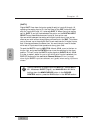
As you are probably aware, video frame rates do not match up exactly with
digital audio sample rates. In a video production environment, if these video
frame rates and digital audio sample rates are not able to be locked together,
this will introduce many problems when it comes time to edit the audio and
video together.
To solve this problem, you may find that you need to "pull up" or "pull
down" the wordclock of the DA7 to match the frame rate of a video signal.
This subject is too involved to go into in great detail here. The DA7 has the
ability to slave to external wordclock, as well as generate fixed pull ups or
pull downs, so you will find that you will be able to resolve most situations
that are common to the film, television and post-production industry.
In most situations, you will "pull down" the sample rate frequency from
44.1kHz to 44.056 kHz or 48 kHz to 47.952. However, in some situations,
you may need to "pull up" the sample rate. This would result in a sample
frequency rate change from 44.1 kHz to 44.144kHz or from 48kHz to
48.048kHz. These two solutions are the most common for film, television
and post-production.
If you are not familiar with the terms and situations discussed in the previous
paragraphs, it might be wise to do some further research. An excellent
reference guide for this and other timecode issues is available from SPARS
(the Society of Professional Audio Recording Studios). You can contact them
at their web site at www.spars.com/spars.
The ability to adjust the wordclock of the DA7 audio is determined by the
value entered in the [±0.1%] field of the [V SYNC] area of the [D-
I/O>INPUT SET] window.
Chapter 12
DA7 Users’ Guide
12
-
6
12
D-I/O
Fs
44.1kHz
44.1kHz
48kHz
48kHz
UP/DOWN
UP
DOWN
UP
DOWN
Adjustment
+0.1%
- 0.1%
+0.1%
- 0.1%
Frequency
44.144kHz
44.056kHz
48.084kHz
47.952kHz


















